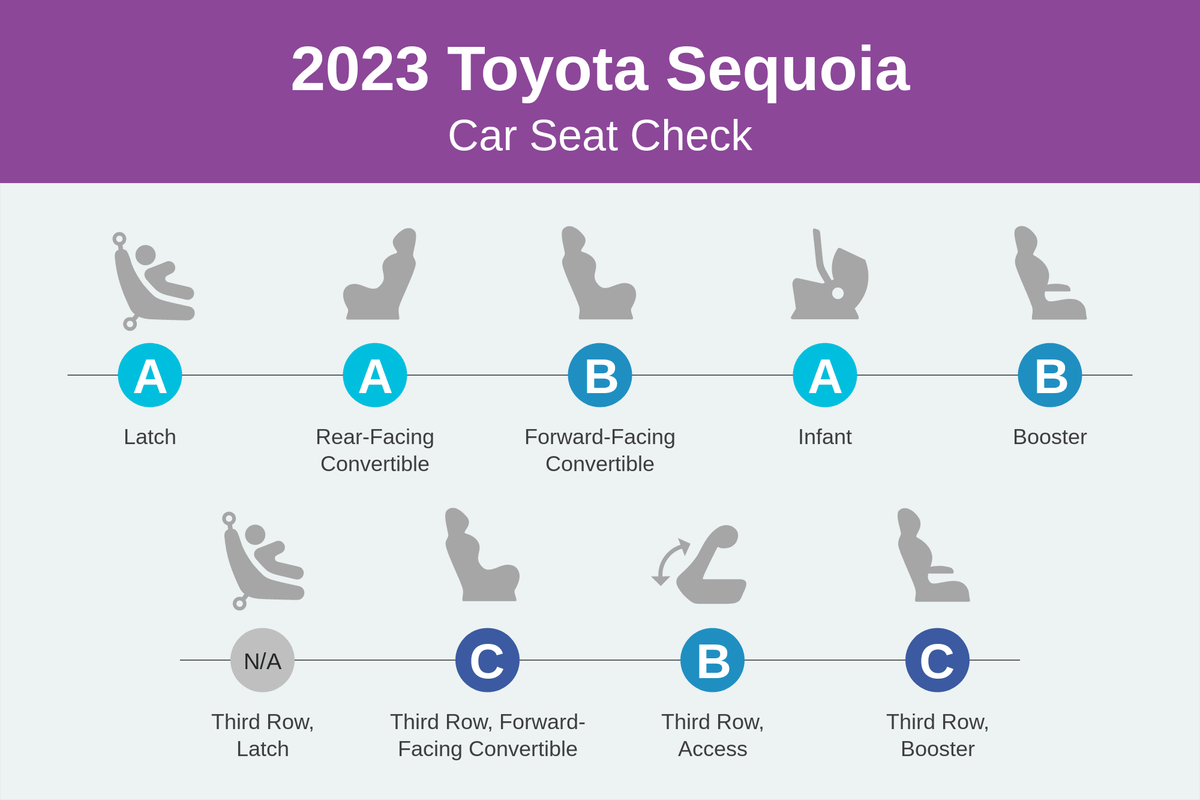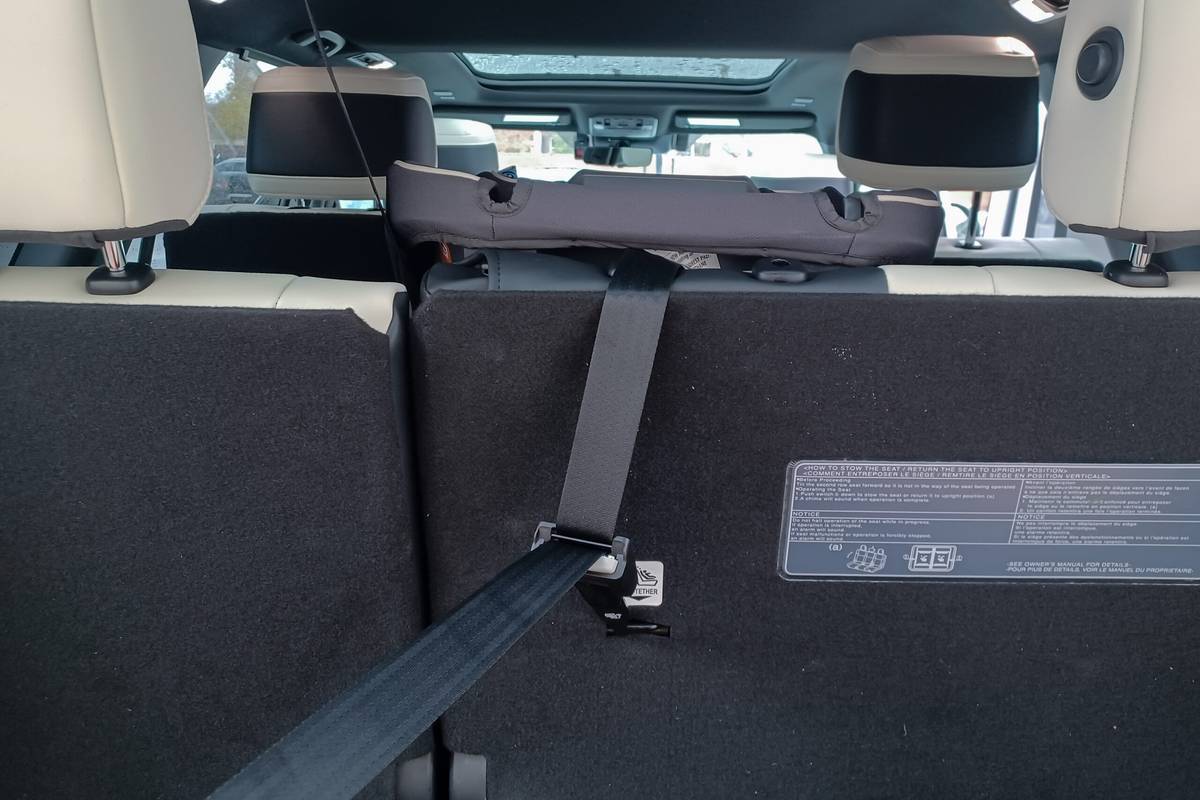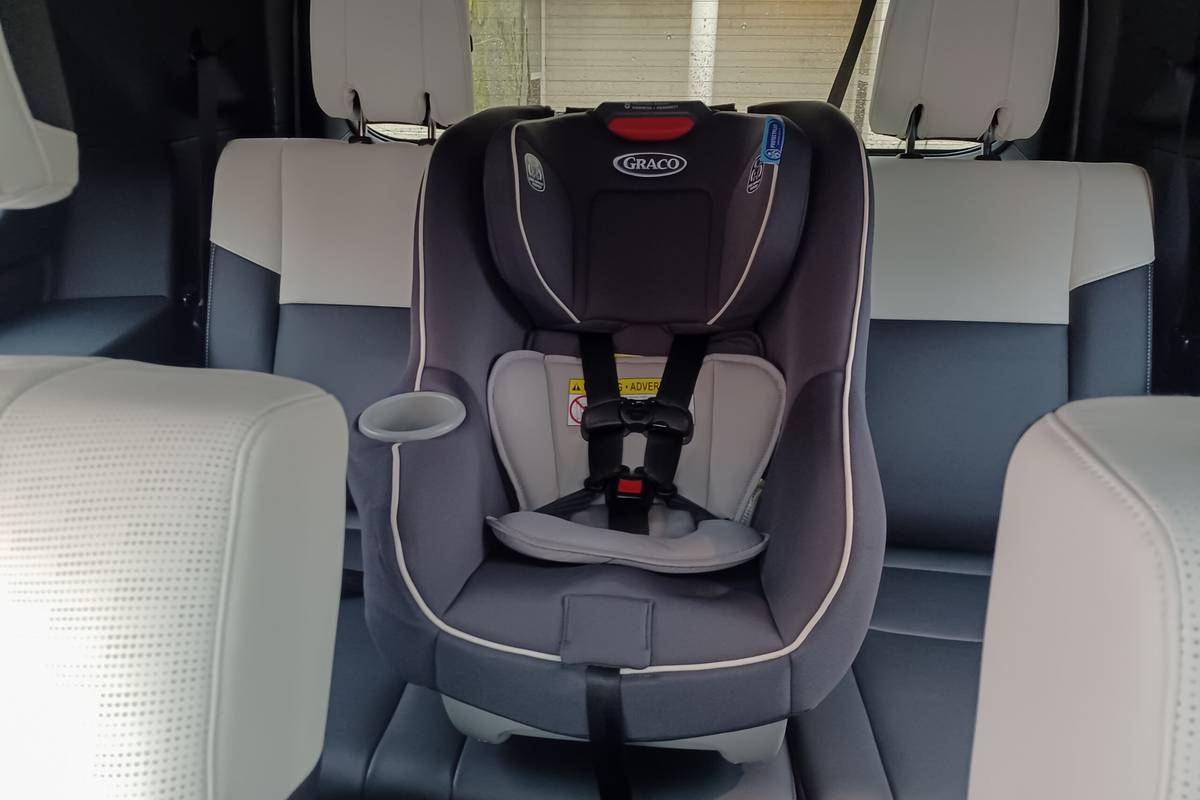How Do Car Seats Fit in a 2023 Toyota Sequoia?


The verdict: The rugged Toyota Sequoia got updated for 2023 with a fresh face and more room inside. Does that mean the previous model’s tiny third row has improved, too? Not exactly; there’s actually less third-row legroom this model year, so space is still an issue, as are the model’s third-row head restraints and top tether anchor, earning it low grades.
Does it fit three car seats? No, due to the second row captain’s chairs.
Take a look at how the Latch system and each car seat scored below in our Car Seat Check of the 2023 Toyota Sequoia.
Related: Search Car Seat Checks

A Grade
- Latch: In the second row, the two sets of lower anchors are exposed and easy to use. Two top tether anchors sit on the seatback; they’re clearly marked, but the anchors themselves are embedded in the seatback carpet, requiring a bit of digging to connect.
- Infant: Installation was easy, and our 5-foot-6-inch front passenger had a comfortable amount of legroom in front of the seat.
- Rear-facing convertible: Again, we had no trouble installing the seat, and our front passenger fit well in front of this car seat.

B Grade
- Forward-facing convertible: Connection to the lower anchors was easy, and the seat fit well on the wide seat-bottom cushion after we removed the head restraint to situate it flush against the seatback. While the top tether anchor is clearly labeled on the seatback, it’s nestled in the carpet and requires some digging to connect.
- Booster: After raising the head restraint, the booster fit well in the second row. The Sequoia’s buckles are on short stalks that slide into pockets, which could make them tough for kids to use independently.
- Third-row access: The second-row seats tumble forward easily, opening up a wide space to get to the third row, but not when a car seat or booster is there. Alternatively, occupants can squeeze through the smaller pass-through between the captain’s chairs, but they must also climb over a low center console.

C Grade
- Third-row forward-facing convertible: There are no lower anchors in the third row, so we used the seat belt to install the convertible into the middle seat. This spot is where the SUV’s sole third-row top tether anchor is, and it’s also the only seat in the third row with a removable head restraint, which affects how the car seat sits against the seatback. The middle spot is narrow, however, crowding the buckles for the other two seats, and the middle seat’s buckle comes down from the ceiling, blocking the driver’s view when in use. Lastly, the top tether anchor is buried in the seatback carpet, complicating connection.
- Third-row booster: The outboard seats’ head restraints don’t come out; instead, they flip forward and prevent the booster from sitting flush with the seatback. The booster can be installed in the middle spot, where the head restraint is removable, but the buckle comes down from the ceiling, blocking the driver’s view. Also, the third row’s buckles are floppy, which might make them tough for kids to grasp and use independently.

Grading Scale
A: Plenty of room for the car seat and the child; doesn’t impact driver or front-passenger legroom. Easy to find and connect to Latch and tether anchors. No fit issues involving head restraint or seat contouring. Easy access to the third row.
B: One room, fit or connection issue. Some problems accessing the third row when available.
C: Marginal room plus one fit or connection issue. Difficult to access the third row when available.
D: Insufficient room, plus multiple fit or connection issues.
F: Does not fit or is unsafe.
About Cars.com’s Car Seat Checks
Editors Jennifer Geiger and Jennifer Newman are certified child safety seat installation technicians.
For the Car Seat Check, we use a Chicco KeyFit 30 infant-safety seat, a Graco Contender 65 convertible seat and Graco TurboBooster seat. The front seats are adjusted for a 6-foot driver and a shorter passenger. The three child seats are installed in the second row. The booster seat sits behind the driver’s seat, and the infant and convertible seats are installed behind the front passenger seat.
We also install the forward-facing convertible in the second row’s middle seat with the booster and infant seat in the outboard seats to see if three car seats will fit; a child sitting in the booster seat must be able to reach the seat belt buckle. If there’s a third row, we install the booster seat and a forward-facing convertible. Learn more about how we conduct our Car Seat Checks.
Parents should also remember that they can use the Latch system or a seat belt to install a car seat, and that Latch anchors have a weight limit of 65 pounds, including the weight of the child and the weight of the seat itself.
Cars.com’s Editorial department is your source for automotive news and reviews. In line with Cars.com’s long-standing ethics policy, editors and reviewers don’t accept gifts or free trips from automakers. The Editorial department is independent of Cars.com’s advertising, sales and sponsored content departments.

News Editor Jennifer Geiger joined the automotive industry in 2003, much to the delight of her Corvette-obsessed dad. Jennifer is an expert reviewer, certified car-seat technician and mom of three. She wears a lot of hats — many of them while driving a minivan.
Featured stories




